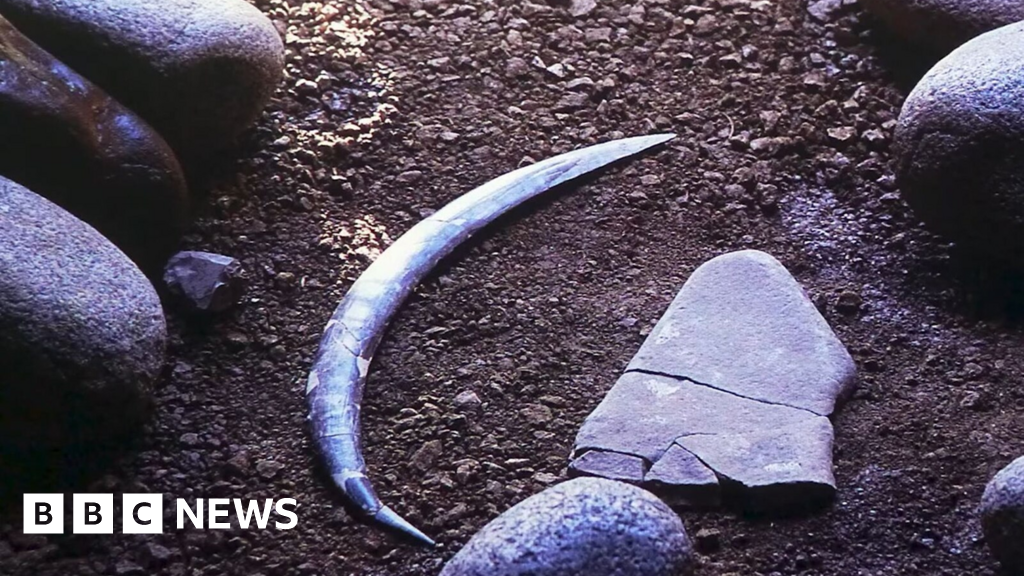The world's oldest boomerang is older than previously thought, casting new light on the ingenuity of humans living at the time. The tool, which was found in a cave in Poland in 1985, is now thought to be 40,000 years old. Archaeologists say it was fashioned from a mammoth's tusk with an astonishing level of skill. Researchers worked out from its shape that it would have flown when thrown, but would not have come back to the thrower. It was probably used in hunting, though it might have had cultural or artistic value, perhaps being used in some kind of ritual. The mammoth ivory boomerang was unearthed in Oblazowa Cave in southern Poland. It was originally thought to be about 30,000 years old. But new, more reliable radiocarbon dating of human and animal bones found at the site puts the age at between 39,000 and 42,000 years old. "It's the oldest boomerang in the world, and the only one in the world made of this shape and this long to be found in Poland," said Dr Sahra Talamo of the University of Bologna, Italy. It gives a "remarkable insight" into human behaviour, she said, particularly how Homo sapiens living as long as 42,000 years ago could shape "such a perfect object" with the knowledge it could be used to hunt animals. The boomerang is exceptionally well preserved, with score marks suggesting it had been polished and carved for use by a right-handed individual. Boomerangs are generally associated with Aboriginal culture in Australia. However, rare finds in the historical record outside Australia suggest they were used across different continents. The oldest known boomerang from Australia dates to about 10,500 years ago, made from wood. But the oldest images of boomerangs in Australia are rock art paintings 20,000 years old, according to National Museum Australia. A wooden boomerang dating back 7,000 years has been found in Jutland, a peninsula between Denmark and Germany, while fragments of a 2,000-year-old oak boomerang – which does come back – has been found in The Netherlands. The research by a team of scientists from Poland, Italy, Germany, France, Switzerland and the UK is published in the journalPLOS One.
World's oldest boomerang doesn't actually come back
TruthLens AI Suggested Headline:
"Research Reveals World's Oldest Boomerang Dates Back 40,000 Years"
TruthLens AI Summary
Recent research has revealed that the world's oldest known boomerang, discovered in a cave in Poland, is significantly older than previously estimated, now believed to be around 40,000 years old. Originally thought to be approximately 30,000 years old, this remarkable artifact was crafted from mammoth tusk, showcasing an impressive level of skill and craftsmanship by humans of that era. Archaeologists determined that the boomerang's design would allow it to fly effectively when thrown, although it was not engineered to return to the thrower. It is posited that the tool was primarily used for hunting, but it may also have held cultural or artistic significance, potentially serving a role in rituals. The discovery was made in Oblazowa Cave, located in southern Poland, and the new age estimates were derived from advanced radiocarbon dating techniques applied to human and animal remains unearthed at the site.
Dr. Sahra Talamo from the University of Bologna emphasized the significance of this find, noting that it provides a unique insight into the behaviors and capabilities of Homo sapiens living 42,000 years ago. The exceptional preservation of the boomerang includes distinct score marks that suggest it was polished and carved for use by a right-handed person. While boomerangs are often linked to Aboriginal culture in Australia, this discovery indicates that similar tools were utilized across different continents. Notably, the oldest known Australian boomerang dates back to approximately 10,500 years ago, and other ancient boomerangs have been found in Europe. The findings were reported by an international team of scientists and published in the journal PLOS One, highlighting the global history and diversity of this iconic tool.
TruthLens AI Analysis
You need to be a member to generate the AI analysis for this article.
Log In to Generate AnalysisNot a member yet? Register for free.
